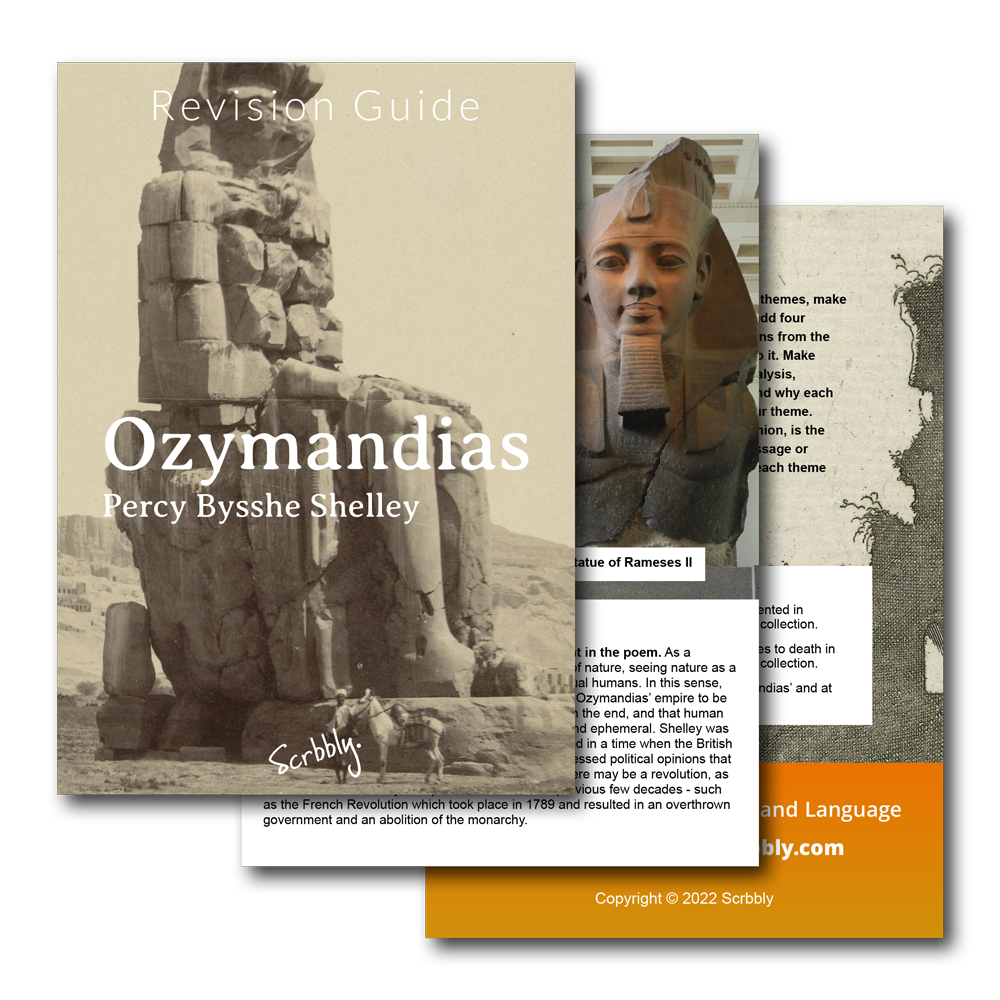This essay gives an example of the standard required to achieve an L7 grade (the equivalent of an ‘A’) at GCSE and iGCSE level. The question is taken from a Cambridge (CAIE) style exam format, but it could be applied to a range of different exam boards.
THE QUESTION:
Write about the way in which Shelley presents power in Ozymandias. (WJEC /Eduqas)
“Examine the ways in which Shelley explores feelings about power in the poem “Ozymandias”. (Cambridge / CAIE)
Note: For AQA, bear in mind that the structure has to be comparative, talking about both poems together and drawing important comparisons or contrasts on the topic.
Thanks for reading! Find more of our English Literature and Language courses on the links below:
CAIE IGCSE Poetry 2023-2025 (Songs of Ourselves, Volume 2, Part 4)
CAIE IGCSE Poetry 2023-2025 (Songs of Ourselves, Volume 1, Part 4)
AQA GCSE Power and Conflict Poetry
THE ESSAY:
In “Ozymandias,” Percy Bysshe Shelley explores the theme of power through the portrayal of a fallen king and his crumbling statue. The poem’s imagery and language convey the transience of human power and the ultimate insignificance of even the most powerful rulers. Through the use of structural devices such as enjambment and imagery, Shelley effectively highlights the fleeting nature of power and the hubris of those who seek to control it.
The first way in which Shelley explores feelings about power in “Ozymandias” is through the description of the statue itself. The statue is described as “two vast and trunkless legs of stone” and “a shattered visage” which suggests that the king, once powerful and imposing, is now reduced to nothing more than a broken and insignificant remnant of his former self. The use of imagery in this description serves to highlight the fleeting nature of power and the eventual downfall of even the greatest rulers. Additionally, the use of enjambment in this line, where the line breaks abruptly between “two vast” and “and trunkless,” adds to the sense of the statue being incomplete and broken, further emphasizing the idea of the king’s power being reduced to nothing.
The second way in which Shelley explores feelings about power in “Ozymandias” is through the use of the inscription on the statue’s base. The inscription, which reads “My name is Ozymandias, king of kings: Look on my works, ye Mighty, and despair!”, emphasises the king’s hubris and the futility of his attempts to immortalize himself through his works. The use of imperative language, “Look on my works,” serves to highlight the king’s desire for control and admiration. The repetition of the word “my” further emphasizes the king’s ego and his belief that his power and works belong only to him. The inscription also serves to mock the king’s attempts to control how he will be remembered, as his statue and inscription have been reduced to nothing more than a “colossal wreck” in the desert.
Ted Hughes Poetry Essay Questions
The third way in which Shelley explores feelings about power in “Ozymandias” is through the use of the traveller as the narrator of the poem. The traveller is able to reflect on the statue and the inscription, and through his observations, the reader is able to gain a sense of perspective on the king and his reign. The use of a first-person narrator serves to underscore the idea that all power is fleeting and that even the greatest rulers will eventually be forgotten. The traveler’s presence in the poem also serves as a contrast to the king’s hubris, reminding the reader that even the most powerful leaders are ultimately mortal and insignificant.
In “Ozymandias,” Shelley effectively explores feelings about power through the use of imagery, language, and structural devices. Through the portrayal of a fallen king and his crumbling statue, Shelley conveys the transience of human power and the ultimate insignificance of even the most powerful rulers. The use of enjambment, imagery, and first-person narration serve to highlight the fleeting nature of power and the hubris of those who seek to control it. The poem serves as a reminder of the fleeting nature of power and the futility of attempts to immortalize oneself through one’s works.
FEEDBACK:
- No need to mention techniques in the introduction
- Great register – using precise academic language
- Good, clear structure – the topic sentences could be stronger for the middle paragraphs, they are a bit repetitive
- Contextual points would deepen your analysis – consider adding in 1-2 context points in the middle paragraphs
- A good application of both language devices and structural features
- A clear understanding of themes and messages – although a little repetitive in your ideas at times
- Try to avoid saying ‘the word’ and instead say the technique, e.g. ‘the possessive pronoun ‘my’
- Clear conclusion, but a little repetitive – try to add something more to your thesis here












